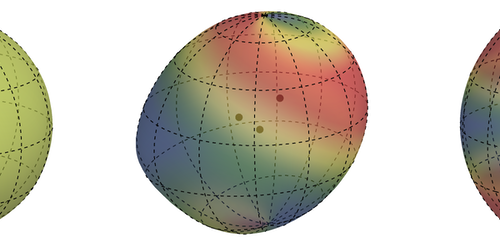A Way to Experimentally Test String Theory’s “Fuzzball” Prediction
Stephen Hawking predicted that black holes can evaporate through the emission of thermal radiation. That’s a problem as evaporation implies the disappearance of information, which violates the laws of quantum mechanics. A proposal from string theorists that replaces a classical black hole with a “fuzzball” of vibrating strings resolves the paradox, but the proposal has yet to be experimentally confirmed. Now, using numerical simulations, Taishi Ikeda of the Sapienza University of Rome and his colleagues predict that a measurable observable from two colliding fuzzballs could be used to confirm the theory [1].
When two black holes merge, the newly formed entity shakes and emits gravitational waves as it “rings down.” On Earth, the LIGO and Virgo gravitational-wave detectors have picked up such signals and confirmed that they match the predictions of the general theory of relativity for classical black holes (see Viewpoint: The First Sounds of Merging Black Holes). To explore whether merging fuzzy black holes produce similar signals, Ikeda and his colleagues simulated a fuzzball that they subjected to quadrupolar perturbations.
Externally perturbing the system with a decaying force, the team found that the initial gravitational-wave signal from the object mimicked the initial ringdown of a classical black hole formed after a binary collision. However, at later times, when just a few long-lived modes persisted, the amplitude of the signal decayed more slowly in the fuzzball simulations, something the team linked to the lack of a well-defined event horizon for the object. They also found that the later signal was dominated by “echoes” of the original signal, which came from radiation trapped within the fuzzball. The team says that the fuzzball signal might be large enough to detect by current gravitational-wave detectors.
–Rachel Berkowitz
Rachel Berkowitz is a Corresponding Editor for Physics Magazine based in Vancouver, Canada.
References
- T. Ikeda et al., “Black-hole microstate spectroscopy: Ringdown, quasinormal modes, and echoes,” Phys. Rev. D 104, 066021 (2021).




